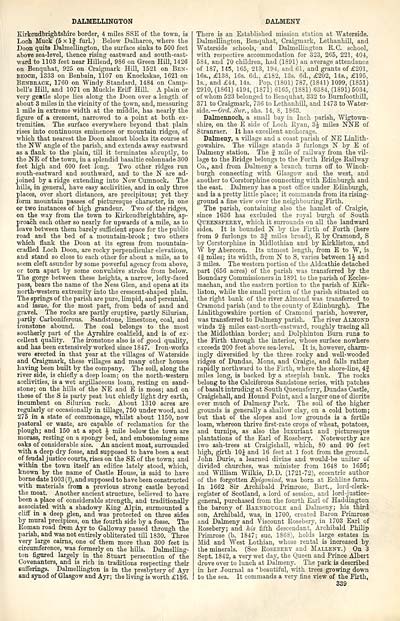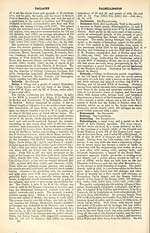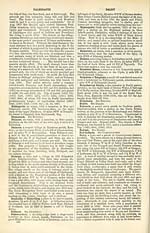Ordnance gazetteer of Scotland
(347) Page 339
Download files
Complete book:
Individual page:
Thumbnail gallery: Grid view | List view

DALMELLINGTON
Kirkcudbrightshire border, 4 miles SSE of the town, is
Loch Muck (5 x If furl. ) Below Dalharco, where the
Doon quits Dalmellington, the surface sinks to 500 feet
above sea-level, thence rising eastward and south-east-
ward to 1103 feet near Hilleud, 986 on Green Hill, 1426
on Benquhat, 925 on Craigmark Hill, 1521 on Ben-
beooh, 1333 on Benbain, 1107 on Knockskae, 1621 on
Benbeaok, 1760 on Windy Standard, 1484 on Camp-
bell's Hill, and 1071 on Muckle Eriff Hill. A plain or
very ge»tle slope lies along the Doon over a length of
about 3 miles in the vicinity of the town, and, measuring
1 mile in extreme width at the middle, has nearly the
figure of a crescent, narrowed to a point at both ex-
tremities. The surface everywhere beyond that plain
rises into continuous eminences or mountain ridges, of
which that nearest the Doon almost blocks its course at
the NW angle of the parish, and extends away eastward
as a flank to the plain, till it terminates abruptly, to
the NE of the town, in a splendid basaltic colonnade 300
feet high and 600 feet long. Two other ridges run
south-eastward and southward, and to the N are ad-
joined by a ridge extending into New Cumnock. The
hills, in general, have easy acclivities, and in only three
places, over short distances, are precipitous; yet they
form mountain passes of picturesque character, in one
or two instances of high grandeur. Two of. the ridges,
on the way from the town to Kirkcudbrightshire, ap-
proach each other so nearly for upwards of a mile, as to
leave between them barely sufficient space for the public
road and the bed of a mountain-brook ; two others
which flank the Doon at its egress from mountain-
cradled Loch Doon, are rocky perpendicular elevations,
and stand so close to each other for about a mile, as to
seem cleft asunder by some powerful agency from above,
or torn apart by some convulsive stroke from below.
The gorge between these heights, a narrow, lofty -faced
pass, bears the name of the Ness Glen, and opens at its
north-western extremity into the crescent-shaped plain.
The springs of the parish are pure, limpid, and perennial,
and issue, for the most part, from beds of sand and
gravel. The rocks are partly eruptive, partly Silurian,
partly Carboniferous. Sandstone, limestone, coal, and
ironstone abound. The coal belongs to the most
southerly part of the Ayrshire coalfield, and is of ex-
cellent quality. The ironstone also is of good quality,
and has been extensively worked since 1S47. Iron-works
were erected in that year at the villages of Waterside
and Craigmark, these villages and many other houses
having been built by the company. The soil, along the
river side, is chiefly a deep loam; on the north-western
acclivities, is a wet argillaceous loam, resting on sand-
stone; on the hills of the NE and E is moss; and on
those of the S is party peat but chiefly light dry earth,
incumbent on Silurian rock. About 1310 acres are
regularly or occasionally in tillage, 750 under wood, and
275 in a state of commonage, whilst about 1150, now
pastoral or waste, are capable of reclamation for the
plough; and 150 at a spot \ mile below the town are
morass, resting on a spongy bed, and embosoming some
oaks of considerable size. An ancient moat, surrounded
with a deep dry fosse, and supposed to have been a seat
of feudal justice courts, rises on the SE of the town; and
within the town itself an edifice lately stood, which,
known by the name of Castle House, is said to have
borne date 1003 (?), and supposed to have been constructed
with materials from a previous strong castle beyond
the moat. Another ancient structure, believed to have
been a place of considerable strength, and traditionally
associated with a shadowy King Alpin, surmounted a
cliff in a deep glen, and was protected on three sides
by mural precipices, on the fourth side by a fosse. The
Roman road from Ayr to Galloway passed through the
parish, and was not entirely obliterated till 1830. Three
very large cairns, one of them more than 300 feet in
circumference, was formerly on the hills. Dalmelling-
ton figured largely in the Stuart persecution of the
Covenanters, and is rich in traditions respecting their
sufferings. Dalmellington is in the presbytery of Ayr
and synod of Glasgow and Ayr; the living is worth £186.
DALMENY
There is an Established mission station at Waterside.
Dalmellington, Benquhat, Craigmark, Lethanhill, and
Waterside schools, and Dalmellington R.C. school,
with respective accommodation for 323, 265, 221, 404,
584, and 70 children, had (1891) an average attendance
of 187, 145, 165, 213, 194, and 61, and grants of £201,
16s., £138, 16s. 6d., £182, 13s. 6d., £202, 14s., £195,
Is., and £44, 14s. Pop. (1801) 787, (1S41) 1099, (1851)
2910, (1861) 4194, (1871) 6165, (1S81) 6384, (1891) 5034,
of whom 523 belonged to Benquhat, 332 to Burnfoothill,
371 to Craigmark, 736 to Lethanhill, and 1473 to Water-
side.— Ord. Sur., shs. 14, 8, 1863.
Dalmennoch, a small bay in Inch parish, Wigtown-
shire, on the E side of Loch Ryan, 3£ miles NNE of
Stranraer. It has excellent anchorage.
Dalmeny, a village and a coast parish of NE Linlith-
gowshire. The village stands 3 furlongs N by E of
Dalmeny station. The f mile of railway from the vil-
lage to the Bridge belongs to the Forth Bridge Railway
Co., and from Dalmeny a branch turns off to Winch-
burgh connecting with Glasgow and the west, and
another to Corstorphine connecting with Edinburgh and
the east. Dalmeny has a post office under Edinburgh,
and is a pretty little place; it commands from its rising-
ground a fine view over the neighbouring Firth.
The parish, containing also the hamlet of Craigie,
since 1636 has excluded the royal burgh of South
Queensfekry, which it surrounds on all the landward
sides. It is bounded N by the Firth of Forth (here
from 9 furlongs to 3| miles broad), E by Cramond, S
by Corstorphine in Midlothian and by Kirkliston, and
W by Abercorn. Its utmost length, from E to W, is
4| miles; its width, from N to S, varies between 1£ and
3 miles. The western portion of the Aldcathie detached
part (656 acres) of the parish was transferred by the
Boundary Commissioners in 1891 to the parish of Eccles-
machan, and the eastern portion to the parish of Kirk-
liston, while the small portion of the parish situated on
the right bank of the river Almond was transferred to
Cramond parish (and to the county of Edinburgh). The
Linlithgowshire portion of Cramond parish, however,
was transferred to Dalmeny parish. The river Almond
winds 2J miles east-north-eastward, roughly tracing all
the Midlothian border; and Dolphinton Burn runs to
the Firth through the interior, whose surface nowhere
exceeds 200 feet above sea-level. It is, however, charm-
ingly diversified by the three rocky and well-wooded
ridges of Dundas, Mons, and Craigie, and falls rather
rapidly northward to the Firth, where the shore-line, 4f
miles long, is backed by a steepish bank. The rocks
belong to the Calciferous Sandstone series, with patches
of basalt intruding at South Queensferry, Dundas Castle,
Craigiehall, and Hound Point, and a larger one of diorite
over much of Dalmeny Park. The soil of the higher
grounds is generally a shallow clay, on a cold bottom;
but that of the slopes and low grounds is a fertile
loam, whereon thrive first-rate crops of wheat, potatoes,
and turnips, as also the luxuriant and picturesque
plantations of the Earl of Rosebery. Noteworthy are
two ash-trees at Craigiehall, which, 80 and 90 feet
high, girth 10J and 16 feet at 1 foot from the ground.
John Durie, a learned divine and would-be uniter of
divided churches, was minister from 1648 to 1656;
and William Wilkie, D.D. (1721-72), eccentric author
of the forgotten Epigoniad, was born at Ecliline farm.
In 1662 Sir Archibald Primrose, Bart., lord-clerk-
register of Scotland, a lord of session, and lord-justice-
general, purchased from the fourth Earl of Haddington
the barony of Barnbougle and Dalmeny; his third
son, Archibald, was, in 1700, created Baron Primrose
and Dalmeny and Viscount Rosebery, in 1703 Earl of
Rosebery; and his fifth descendant, Archibald Philip
Primrose (b. 1847; sue. 186S), holds large estates in
Mid and West Lothian, whose rental is increased by
the minerals. (See Rosebery and Malleny.) On 3
Sept. 1842, a very wet day, the Queen and Prince Albert
drove over to lunch at Dalmeny. The park is described
in her Journal as ' beautiful, with trees growing down
to the sea. It commands a very fine view of the Firth,
339
Kirkcudbrightshire border, 4 miles SSE of the town, is
Loch Muck (5 x If furl. ) Below Dalharco, where the
Doon quits Dalmellington, the surface sinks to 500 feet
above sea-level, thence rising eastward and south-east-
ward to 1103 feet near Hilleud, 986 on Green Hill, 1426
on Benquhat, 925 on Craigmark Hill, 1521 on Ben-
beooh, 1333 on Benbain, 1107 on Knockskae, 1621 on
Benbeaok, 1760 on Windy Standard, 1484 on Camp-
bell's Hill, and 1071 on Muckle Eriff Hill. A plain or
very ge»tle slope lies along the Doon over a length of
about 3 miles in the vicinity of the town, and, measuring
1 mile in extreme width at the middle, has nearly the
figure of a crescent, narrowed to a point at both ex-
tremities. The surface everywhere beyond that plain
rises into continuous eminences or mountain ridges, of
which that nearest the Doon almost blocks its course at
the NW angle of the parish, and extends away eastward
as a flank to the plain, till it terminates abruptly, to
the NE of the town, in a splendid basaltic colonnade 300
feet high and 600 feet long. Two other ridges run
south-eastward and southward, and to the N are ad-
joined by a ridge extending into New Cumnock. The
hills, in general, have easy acclivities, and in only three
places, over short distances, are precipitous; yet they
form mountain passes of picturesque character, in one
or two instances of high grandeur. Two of. the ridges,
on the way from the town to Kirkcudbrightshire, ap-
proach each other so nearly for upwards of a mile, as to
leave between them barely sufficient space for the public
road and the bed of a mountain-brook ; two others
which flank the Doon at its egress from mountain-
cradled Loch Doon, are rocky perpendicular elevations,
and stand so close to each other for about a mile, as to
seem cleft asunder by some powerful agency from above,
or torn apart by some convulsive stroke from below.
The gorge between these heights, a narrow, lofty -faced
pass, bears the name of the Ness Glen, and opens at its
north-western extremity into the crescent-shaped plain.
The springs of the parish are pure, limpid, and perennial,
and issue, for the most part, from beds of sand and
gravel. The rocks are partly eruptive, partly Silurian,
partly Carboniferous. Sandstone, limestone, coal, and
ironstone abound. The coal belongs to the most
southerly part of the Ayrshire coalfield, and is of ex-
cellent quality. The ironstone also is of good quality,
and has been extensively worked since 1S47. Iron-works
were erected in that year at the villages of Waterside
and Craigmark, these villages and many other houses
having been built by the company. The soil, along the
river side, is chiefly a deep loam; on the north-western
acclivities, is a wet argillaceous loam, resting on sand-
stone; on the hills of the NE and E is moss; and on
those of the S is party peat but chiefly light dry earth,
incumbent on Silurian rock. About 1310 acres are
regularly or occasionally in tillage, 750 under wood, and
275 in a state of commonage, whilst about 1150, now
pastoral or waste, are capable of reclamation for the
plough; and 150 at a spot \ mile below the town are
morass, resting on a spongy bed, and embosoming some
oaks of considerable size. An ancient moat, surrounded
with a deep dry fosse, and supposed to have been a seat
of feudal justice courts, rises on the SE of the town; and
within the town itself an edifice lately stood, which,
known by the name of Castle House, is said to have
borne date 1003 (?), and supposed to have been constructed
with materials from a previous strong castle beyond
the moat. Another ancient structure, believed to have
been a place of considerable strength, and traditionally
associated with a shadowy King Alpin, surmounted a
cliff in a deep glen, and was protected on three sides
by mural precipices, on the fourth side by a fosse. The
Roman road from Ayr to Galloway passed through the
parish, and was not entirely obliterated till 1830. Three
very large cairns, one of them more than 300 feet in
circumference, was formerly on the hills. Dalmelling-
ton figured largely in the Stuart persecution of the
Covenanters, and is rich in traditions respecting their
sufferings. Dalmellington is in the presbytery of Ayr
and synod of Glasgow and Ayr; the living is worth £186.
DALMENY
There is an Established mission station at Waterside.
Dalmellington, Benquhat, Craigmark, Lethanhill, and
Waterside schools, and Dalmellington R.C. school,
with respective accommodation for 323, 265, 221, 404,
584, and 70 children, had (1891) an average attendance
of 187, 145, 165, 213, 194, and 61, and grants of £201,
16s., £138, 16s. 6d., £182, 13s. 6d., £202, 14s., £195,
Is., and £44, 14s. Pop. (1801) 787, (1S41) 1099, (1851)
2910, (1861) 4194, (1871) 6165, (1S81) 6384, (1891) 5034,
of whom 523 belonged to Benquhat, 332 to Burnfoothill,
371 to Craigmark, 736 to Lethanhill, and 1473 to Water-
side.— Ord. Sur., shs. 14, 8, 1863.
Dalmennoch, a small bay in Inch parish, Wigtown-
shire, on the E side of Loch Ryan, 3£ miles NNE of
Stranraer. It has excellent anchorage.
Dalmeny, a village and a coast parish of NE Linlith-
gowshire. The village stands 3 furlongs N by E of
Dalmeny station. The f mile of railway from the vil-
lage to the Bridge belongs to the Forth Bridge Railway
Co., and from Dalmeny a branch turns off to Winch-
burgh connecting with Glasgow and the west, and
another to Corstorphine connecting with Edinburgh and
the east. Dalmeny has a post office under Edinburgh,
and is a pretty little place; it commands from its rising-
ground a fine view over the neighbouring Firth.
The parish, containing also the hamlet of Craigie,
since 1636 has excluded the royal burgh of South
Queensfekry, which it surrounds on all the landward
sides. It is bounded N by the Firth of Forth (here
from 9 furlongs to 3| miles broad), E by Cramond, S
by Corstorphine in Midlothian and by Kirkliston, and
W by Abercorn. Its utmost length, from E to W, is
4| miles; its width, from N to S, varies between 1£ and
3 miles. The western portion of the Aldcathie detached
part (656 acres) of the parish was transferred by the
Boundary Commissioners in 1891 to the parish of Eccles-
machan, and the eastern portion to the parish of Kirk-
liston, while the small portion of the parish situated on
the right bank of the river Almond was transferred to
Cramond parish (and to the county of Edinburgh). The
Linlithgowshire portion of Cramond parish, however,
was transferred to Dalmeny parish. The river Almond
winds 2J miles east-north-eastward, roughly tracing all
the Midlothian border; and Dolphinton Burn runs to
the Firth through the interior, whose surface nowhere
exceeds 200 feet above sea-level. It is, however, charm-
ingly diversified by the three rocky and well-wooded
ridges of Dundas, Mons, and Craigie, and falls rather
rapidly northward to the Firth, where the shore-line, 4f
miles long, is backed by a steepish bank. The rocks
belong to the Calciferous Sandstone series, with patches
of basalt intruding at South Queensferry, Dundas Castle,
Craigiehall, and Hound Point, and a larger one of diorite
over much of Dalmeny Park. The soil of the higher
grounds is generally a shallow clay, on a cold bottom;
but that of the slopes and low grounds is a fertile
loam, whereon thrive first-rate crops of wheat, potatoes,
and turnips, as also the luxuriant and picturesque
plantations of the Earl of Rosebery. Noteworthy are
two ash-trees at Craigiehall, which, 80 and 90 feet
high, girth 10J and 16 feet at 1 foot from the ground.
John Durie, a learned divine and would-be uniter of
divided churches, was minister from 1648 to 1656;
and William Wilkie, D.D. (1721-72), eccentric author
of the forgotten Epigoniad, was born at Ecliline farm.
In 1662 Sir Archibald Primrose, Bart., lord-clerk-
register of Scotland, a lord of session, and lord-justice-
general, purchased from the fourth Earl of Haddington
the barony of Barnbougle and Dalmeny; his third
son, Archibald, was, in 1700, created Baron Primrose
and Dalmeny and Viscount Rosebery, in 1703 Earl of
Rosebery; and his fifth descendant, Archibald Philip
Primrose (b. 1847; sue. 186S), holds large estates in
Mid and West Lothian, whose rental is increased by
the minerals. (See Rosebery and Malleny.) On 3
Sept. 1842, a very wet day, the Queen and Prince Albert
drove over to lunch at Dalmeny. The park is described
in her Journal as ' beautiful, with trees growing down
to the sea. It commands a very fine view of the Firth,
339
Set display mode to: Large image | Transcription
Images and transcriptions on this page, including medium image downloads, may be used under the Creative Commons Attribution 4.0 International Licence unless otherwise stated. ![]()
| Gazetteers of Scotland, 1803-1901 > Ordnance gazetteer of Scotland > (347) Page 339 |
|---|
| Permanent URL | https://digital.nls.uk/97397410 |
|---|

